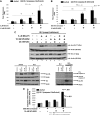Caspase-8 dependent histone acetylation by a novel proteasome inhibitor, NPI-0052: a mechanism for synergy in leukemia cells
- PMID: 19182209
- PMCID: PMC2676087
- DOI: 10.1182/blood-2008-08-174797
Caspase-8 dependent histone acetylation by a novel proteasome inhibitor, NPI-0052: a mechanism for synergy in leukemia cells
Abstract
Combination studies of histone deacetylase inhibitors (HDACi) and proteasome inhibitors are providing preclinical framework to build better strategies against hematologic malignancies. Our previous work found that a novel proteasome inhibitor, NPI-0052, and HDACi synergistically induce apoptosis in leukemia cells in a caspase-8- and oxidant-dependent manner. Here we extend those observations to primary leukemia cells and identify novel mechanisms of synergy. Because the proximal targets of NPI-0052 and HDACi are inhibition of proteasome activity and histone acetylation, we initially examined those biochemical events. Increased acetylation of histone-H3 was detected in Jurkat and CLL primary cells treated with NPI-0052, alone or in combination with various HDACi (MS/SNDX-275 or vorinostat). Hyperacetylation by NPI-0052 occurred to a lesser extent in caspase-8-deficient cells and in cells treated with an antioxidant. These results indicate that NPI-0052 is eliciting caspase-8 and oxidative stress-dependent epigenetic alterations. In addition, real-time PCR revealed that MS/SNDX-275 repressed expression of the proteasomal beta5, beta2, and beta1 subunits, consequently inhibiting respective enzymatic activities. Overall, our results suggest that crosstalk by NPI-0052 and HDACi are contributing, along with caspase-8 activation and oxidative stress, to their synergistic cytotoxic effects in leukemia cells, reinforcing the potential clinical utility of combining these 2 agents.
Figures






References
-
- Mehta PA, Davies SM. Allogeneic transplantation for childhood ALL. Bone Marrow Transplant. 2008;41:133–139. - PubMed
-
- Kassim AA, Chinratanalab W, Ferrara JL, Mineishi S. Reduced-intensity allogeneic hematopoietic stem cell transplantation for acute leukemias: ‘what is the best recipe?’. Bone Marrow Transplant. 2005;36:565–574. - PubMed
-
- O'Brien SM, Kantarjian HM, Cortes J, et al. Results of the fludarabine and cyclophosphamide combination regimen in chronic lymphocytic leukemia. J Clin Oncol. 2001;19:1414–1420. - PubMed
-
- Hijiya N, Hudson MM, Lensing S, et al. Cumulative incidence of secondary neoplasms as a first event after childhood acute lymphoblastic leukemia. JAMA. 2007;297:1207–1215. - PubMed
-
- Lipshultz SE, Lipsitz SR, Sallan SE, et al. Chronic progressive cardiac dysfunction years after doxorubicin therapy for childhood acute lymphoblastic leukemia. J Clin Oncol. 2005;23:2629–2636. - PubMed
Publication types
MeSH terms
Substances
Grants and funding
LinkOut - more resources
Full Text Sources

